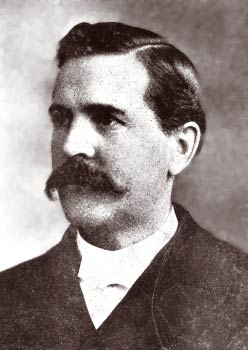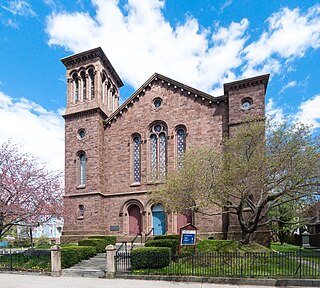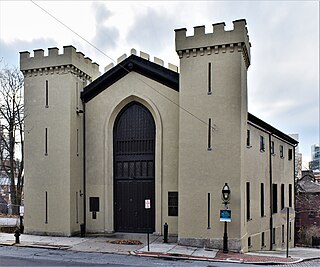
Peace Dale is a village in the town of South Kingstown, Rhode Island. Together with the village of Wakefield, it is treated by the U.S. Census as a component of the census-designated place identified as Wakefield-Peacedale, Rhode Island.

Samuel Hopkins was an American Congregationalist theologian of the late colonial era of the United States. Hopkinsian theology was named for him. Hopkins was an early abolitionist, saying that it was in the interest and duty of the U.S. to set free all of their slaves.

Thomas Alexander Tefft was an American architect, from Providence, Rhode Island. Tefft, one of the nation's first professionally trained architects, is considered a master of Rundbogenstil and a leading American proponent of its use. Prior to his untimely death, Tefft "offered the most advanced designs of [his] day in America"

The Westminster Arcade is a historic shopping center at 130 Westminster Street and 65 Weybosset Street in downtown Providence, Rhode Island built in 1828. It is notable as the first enclosed shopping mall in the United States and has been lauded as a fine example of commercial Greek Revival architecture. It served as a shopping center for many years before falling into decline in the late 20th century. It has since been closed for renovation and rehabilitation several times, and most recently reopened its doors in October 2013 as a residential and commercial mixed-use building. It was declared a National Historic Landmark in 1976.

Henry Jonah Steere (1830–1889) was a prominent American philanthropist and industrialist from Rhode Island.

Russell Warren (1783–1860) was an American architect, best known for his work in the Greek Revival style. He practiced in Bristol and Providence.

Fred A. Hillery was an early leader in the American Holiness Movement; the founding president of the South Providence Holiness Association; the founding pastor of the People's Evangelical Church, the "mother church of the Church of the Nazarene in the East"; a co-founder of the Central Evangelical Holiness Association and also of the Association of Pentecostal Churches of America; one of the founders of the Pentecostal Collegiate Institute ; one of the founding fathers of the Church of the Nazarene; and the publisher of holiness periodicals and books.

S. Stephen's Church is an historic Episcopal church located at 114 George Street in the College Hill neighborhood of Providence, Rhode Island. Located in the midst of the Brown University campus, it is an active parish in the Episcopal Diocese of Rhode Island, with a strong Anglo-Catholic identity.

The United Congregational Church is a historic former church building in Newport, Rhode Island. The congregation was formerly affiliated with the United Church of Christ (UCC). Built in 1857, the church was designated a National Historic Landmark in 2012, in recognition for the unique interior decorations executed in 1880–81 by John La Farge.

Central Falls Congregational Church is an historic church located in Central Falls, Rhode Island. This Shingle style wood-frame structure was built in 1883 to serve a local Congregationalist congregation which was established in 1820 and had outgrown its previous space. Among the members of this church was wadding mill industrialist and Lieutenant governor of Rhode Island Henry A. Stearns.

Newman Congregational Church is an historic church at 100 Newman Avenue in East Providence, Rhode Island. It is a two-story wood-frame structure on a high brick basement. It was built in 1810 for a congregation that was established in 1643, when the area was part of Rehoboth, Massachusetts, and is the oldest Congregationalist organization in Rhode Island.

The Hay and Owen Buildings are a pair of historic commercial buildings in Providence, Rhode Island, United States.

The Market House is a historic three-story brick market house in Market Square, in the College Hill, a neighborhood of Providence, Rhode Island, USA. The building was constructed between 1773 and 1775 and designed by prominent local architects, Joseph Brown and Declaration of Independence signer Stephen Hopkins. The bottom floor of the house was used as a market, and the upper level was used for holding meetings. Similar buildings existed in other American cities, such as Faneuil Hall in Boston and the Old Brick Market in Newport. The building housed the Providence City Council in the decades before the completion of City Hall.

The State Arsenal, originally the Providence Marine Corps of Artillery Arsenal, and commonly called the Benefit Street Arsenal is a historic armory building located at 176 Benefit Street in the College Hill neighborhood of Providence, Rhode Island. It was built in 1829, was designed by Russell Warren in the Gothic Revival style, and was built by Tallman & Bucklin.

Six Principle Baptist Church is a historic church in North Kingstown, Rhode Island. As of 2009 it was one of the last surviving historical congregations of the Six Principle Baptist denomination and one of the oldest churches in the United States.

The Pawtucket Congregational Church is an historic church building at 40 and 56 Walcott Street, at the junction of Broadway and Walcott St., in the Quality Hill neighborhood of Pawtucket, Rhode Island.

John Holden Greene (1777-1850) was a noted early nineteenth century architect practicing in Providence, Rhode Island. The bulk of his work dates to the late Federal period, and is mostly in the architectural style of the same name. Greene is responsible for the design of over fifty buildings built in the city between 1806 and 1830, almost half of which are still standing.

Central Congregational Church is a United Church of Christ congregation established in 1852 in Providence, Rhode Island. The current church building at 296 Angell Street was built in 1893, designed by New York architectural firm Carrère and Hastings. It is part of the Stimson Avenue Historic District. The church has a long tradition of social and community work in the Providence area, the United States and around the world.

James C. Bucklin (1801-1890) was an American architect working in Providence, Rhode Island.

The Plymouth Congregational Church is an historic church building at 1014 Broad Street in Providence, Rhode Island. Completed in 1919 for a congregation founded in 1878, it is a well-preserved example of late Gothic Revival architecture, designed by Boston architect George F. Newton. Since 2016, the building has been home to the Iglesia Visión Evangélica congregation. It was listed on the National Register of Historic Places in 2021.



























